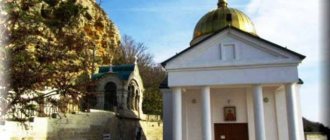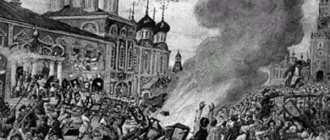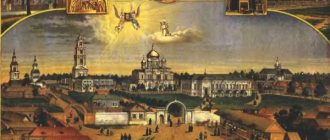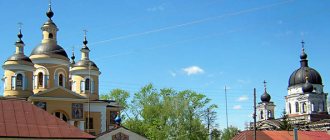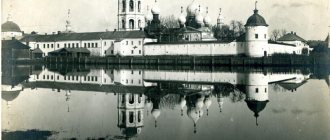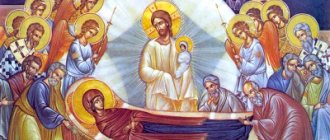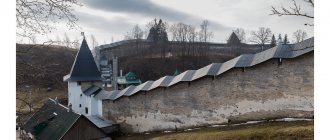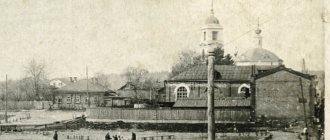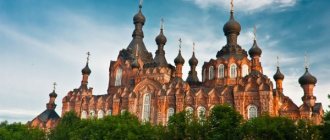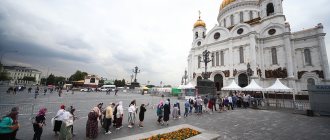Since ancient times, the capital of Ukraine has been famous for its temples and monasteries, attracting pilgrims from everywhere. Many say that a city that is “marked by the finger of God” and literally permeated with the spirit of Christianity brings a sense of harmony and tranquility to a person. The golden domes of numerous Kyiv churches attract the eye, surprising and bewitching tourists, and the architectural forms of numerous religious buildings give real aesthetic pleasure.
In the history of the city, a special place is occupied by such world-famous cathedrals as the Kiev Pechersk Lavra, which is the first Christian monastery in Rus', and St. Sophia Cathedral. The architectural ensemble of the first amazes tourists with its splendor, and in the second you can see unique frescoes dating back to the eleventh century. Both of these cathedrals are considered UNESCO World Heritage Sites. Kyiv is also called “Jerusalem of the Russian land.” After all, it is difficult to convey the intimate experiences that Orthodox Christians experience when they come into contact with the holy places of this ancient city. But the capital of Ukraine, and once also Kievan Rus, is famous not only for the Kiev Pechersk Lavra or St. Sophia Cathedral. There are many other equally interesting temples and churches that everyone who comes here should definitely see. And one of them is the Zverinetsky Monastery in Kyiv.
How to get there
Those who decide to explore this attraction on their own can approach it from Michurina Street - to sections 20 and 22. After passing through the gate, you will need to go up to the metal door. At the entrance to the Zverinetsky Monastery you should call and wait for the guide. You can also get to it through the Botanical Garden, arriving by trolleybus No. 14 or buses No. 62 and 62K from the Pecherskaya metro station. You need to get off at the “Ulitsa Bolsunivskogo” stop. If you go by metro, you need to get off at the Druzhby Narodiv station. From there you can get to the Zverinetsky Monastery in Kyiv, whose address is Michurina Street 20-22, on foot in just fifteen minutes.
To the attention of pilgrimage groups arriving by bus: near the temple, driving and turning around vehicles with a length of more than nine meters is very difficult. Therefore, it is better to park somewhere on Strutinsky Street and, going up the street. Michurin, walk to the cave complex.
Where to stay[edit]
- Holy Dormition Kiev-Pechersk Lavra
House "Lavra Pilgrim"
Address:
Kyiv, st. Lavrskaya, 15
Phones:
+38(044)379-34-05, +38(063)220-99-33 — Lavra Pilgrim House, building No. 58 +38(044)379-34-80, +38(093)381-01- 87 - Lavra Pilgrim House, building No. 54 +38(093)345-01-21 - Lavra Pilgrim House, building No. 56
Reservations for pilgrimage groups are made no earlier than a month in advance. On the territory of the monastery there is a pilgrimage refectory (free) and a pilgrimage cafe (paid).
- Holy Intercession Kiev Convent
At the Holy Intercession Monastery there is a hotel for pilgrims to stay at the hotel for pilgrims of the Intercession Monastery (you need to have a passport with you).
Shelter for three nights is given to all pilgrims, both women and men. Because the monastery is female, a man may not be allowed to live if he is alone, without a wife or not with a pilgrim group.
If there are a lot of pilgrims, and they usually come in large groups, they are placed on mattresses on the floor. Men and women are accommodated in separate rooms. The toilet is shared, the shower is not, documents and money must be kept with you at all times.
Get up at 4:30. There is a service at 5:00, after the service you can eat in the refectory, and if you are not obedient, it is not recommended to be on the territory of the monastery.
Accommodation is free.
Address:
Bekhterevsky lane, 15.
Telephone:
(044) 486-71-68.
- Holy Intercession Monastery (Goloseevskaya Hermitage)
Pilgrims coming to the Holy Intercession Goloseevskaya Hermitage are given the opportunity to settle.
Not far from the temple there is a four-story hotel building with a range of hotel services necessary for living.
When checking in, you must have your passport (original).
At the monastery there is a monastery refectory where you can eat from 8:00 to 20:00, you can also order: lunch for a group of pilgrims, a funeral lunch, to celebrate: the days of the guardian angel, wedding and baptism.
Contacts:
Hotel: +38
Monastery tea room: (096) 052-83-87
Church shop: (098) 900-22-47
Address:
Address: 03041 st. Colonel Zatevakhin, 14.
general information
The Zverinetsky Monastery in Kyiv is located in the historical area of the same name in the capital of Ukraine. It is included in the register of archaeological monuments of national importance for the country. Zverinetsky Cave Monastery has a thousand-year history. It was hidden in the dungeons located on the right bank of the Dnieper River. Humanity learned about the existence of this amazing and unique monastery almost a century and a half ago. However, it must be said that the secrets that the ancient Zverinetsky Monastery in Kyiv hides have not yet been solved.
Scientists found references to the fact that a holy monastery was located on this territory in the chronicles of the Red Court, in which the son of Yaroslav the Wise, Vsevolod, lived. The name “Menagerie,” according to historians, is associated with the wooded area where this prince hunted. It is also known that in 1096–1097 of our chronology, as a result of a raid by nomads, a monastery was destroyed here. Judging by the human bones found in underground cells, both monks and local residents hid in underground caves during the attacks of the Mongol-Tatars, where their attackers often found them and walled them up alive.
The monastery also served as a refuge during World War II. This is evidenced by an inscription found by archaeologists on the wall, dated 1941. Currently, on the basis of the revived monastery of the caves of the same name, the Zverinetsky Monastery for men operates here. It was founded in 2009. It is home to seven inhabitants: five monks and two novices.
KIEV ZVERINETSKY IN THE NAME OF THE ARCHANGEL MICHAEL MONASTERY
(Kiev Metropolis of the UOC), is located in Kyiv (Ukraine), on the right bank of the Dnieper, not far from the Kyiv Ioninsky Monastery in the name of the Holy Trinity. Founded on July 9, 2009 by the decision of the Holy. Synod of the UOC. The earliest mention of the name "Menagerie" dates back to the 1st half. XIII century (the inscription above the altar in the underground church of the cave cemetery: “Igoumeni Zverinnsci Levontiya Markyan Mikhail Iona Mina Klymentya Manuel”). But the name “Menagerie”, as well as information about a possible cave monastery, is not found in the chronicles (Vysotsky. 1985. P. 85).
12 Oct. In 1888, the opening of the Zverinetsky Caves took place. According to legend, the Kiev resident Feodosia Matvienko, who lived near the caves, had monks appear to her three times in a dream asking her to feed them. She took the food to the nearby Ionian Trinity Monastery and asked the brethren to serve a memorial service. On the morning of 12 Oct. Feodosia heard a certain rumble and discovered a fresh sinkhole.
Kyiv Zverinetsky in the name of the architect. Mikhail's husband mon-ry. Photo. 2013 Kiev Zverinetsky in the name of the architect. Mikhail's husband mon-ry. Photo. 2013. Having entered downstairs with a candle, a woman and her neighbor, artist. D. Zaichenko, they saw behind a half-buried wooden door a passage and human remains: some were buried in cells and crypts, others lay on the surface. With the blessing of the rector of the Trinity Monastery, St. Jonah (Miroshnichenko) on the same day, the monks went down into the cave and confirmed the testimony of Matvienko and Zaichenko. Soon, pilgrims began to gather near the caves, curious visitors went down and brought out unique artifacts. The caves were taken under guard by the police, especially since there were artillery warehouses above them, and the territory itself belonged to the Kyiv fortification engineering department as part of the military department.
Oct 14 into gas “The Kiev Word” in section. “Local Chronicle” reported that not far from the Trinity Monastery, in the lower part of Zverinetskaya Mountain, during the extraction of clay, an entrance to a cave was opened. The length of the discovered underground corridor was 68 m. There were 48 burial niches in it, i.e. the cave was an underground cemetery. The caves were visited by Kyiv University professor archaeologist V.B. Antonovich, who already had experience in studying underground monuments, historian Prof. A. V. Prakhov, director of the Kherson Museum of Antiquities V. I. Goshkevich and artist P. A. Svedomsky. A silver cross with a chain in the form of a braid was found, the hryvnia in the middle of the cut had a cross cut out, several. copper crosses, fragments of ancient brick. The remains of leather shoes, leather crosses and belts were sent to the Imp. archaeological commission in St. Petersburg, from where the finds soon returned to Kyiv, to the Museum of the Church Archaeological Society at the KDA. But it was not possible to carry out full-fledged archaeological research in the underground monument at the Menagerie.
Cave corridor of the Church of the Nativity of the Virgin Mary in Kiev Zverinetsky in the name of arch. Mikhail's husband mon-re. Photo. 2013
Cave corridor of the Church of the Nativity of the Virgin Mary in Kiev Zverinetsky in the name of arch. Mikhail's husband mon-re. Photo. 2013 In 1911, the so-called second discovery of caves (Serapion. 1914. pp. 6-7). In the Trinity Monastery it became known about another sinkhole on Zverinetskaya Mountain. Igum. Valentin (Korotenko), who lived in the Trinity Monastery since 1874, well remembered the events of the first discovery of the caves. Igum. Valentine decided to open the ancient underground cemetery for visits by pilgrims. This idea was supported by the official of special assignments under the Kiev, Podolsk and Volyn governor-general, collegiate assessor Prince. V. D. Zhevakhov (see Joasaph (Zhevakhov), schmch., Bishop of Mogilev and Minsk). On June 1, 1912, Zhevakhov signed a contract with the Kyiv Engineering Department, which owned the territory, to lease to it for a period of 6 years a plot of land on the outskirts of Kiev Menagerie for excavations (IMK. F. 1. D. 30-v ( 1908). L. 250). A.D. Ertel, a member of the Kyiv Society for the Protection of Antiquities and Art Monuments and the Kyiv Branch of the Imp. Russian military-historical society, which had experience in conducting archaeological excavations in Kyiv and its environs (TsGIAK. F. 127. Op. 872. D. 123. L. 19-20; F. 725. Op. 1. D. 40. L. 1).
Icon of all the saints of Zverinetsky. Beginning XXI century
Icon of all the saints of Zverinetsky. Beginning XXI century June 7, 1912, with the blessing of the governor of the Kiev-Pechersk Lavra, abbot. Valentin moved from the monastery to a smokehouse built from boards, installed above the Zverinetsky caves. Rumors about the ancient cave quickly spread among believers. To the abbot. Pilgrims, monks and novices from various monasteries in Russia came to Valentin. Gradually a community formed. Igum. Valentin organized the clearing of the caves, for which he paid money from donations. Archaeological excavations were financed in the same way.
Nisha abbot. Kliment Zverinetsky. Photo. 2013
Nisha abbot. Kliment Zverinetsky. Photo. 2013 An open sheet, i.e. permission to carry out excavations, was issued to Imp. archaeological commission in the name of Prince. Zhevakhov as the owner of the land plot on which the underground monument is located. Ertel received an open list for excavations throughout Kyiv and its environs, and therefore had the right to lead excavations in the Zverinetsky caves. S.P. Velmin worked on excavations in the underground monument.
Research in the caves at Menagerie began in Aug. 1912 from preparatory work, and from the end. Sep. They began clearing and excavating. There were 2 entrances open: an ancient one and one dug before the work began for ease of entry into one of the galleries. A total of 3 underground galleries are open: 2 main and a connecting one. In the same year, for the convenience of exploring the caves, a new passage was dug, which connected the underground labyrinth into a ring (Ibid. F. 725. Op. 1. D. 3. L. 154). During the research, it was discovered that the tombs in the caves were looted even before the excavations began. All that remained were scattered bones and several. leather belts, crosses and fragments of ceramics. Several were discovered on the walls of the cave labyrinth. ancient inscriptions. Initially, the materials dated back to the 12th-14th centuries. (Kiev thought. 1913. No. 11. P. 8). The excavations were visited by Chairman Imp. archaeological commission gr. A. A. Bobrinsky. He took with him to the capital some objects and photographs of inscriptions to “determine the era of paleographic material” (Kievlyanin. 1912. No. 324. P. 4).
Zverinetsky cross in the cave church in the name of Arch. Mikhail
Zverinetsky cross in the cave church in the name of Arch. Mikhail V con. In 1912, on the mountainside, above the caves, a wooden house was built on a stone foundation with the intention of consecrating a stone church here (TsGIAK. F. 127. Op. 872. D. 123. L. 1-4). At the same time, the book Zhevakhov tried to transfer the plot to the abbots. Valentin, however, it turned out to be impossible to formalize this legally. To the beginning 1913 Zverinetsky community, created by abbot. Valentine, began to be called the monastery. The prince met with the abbot of the Ionian Trinity Monastery, Archimandrite. Juvenaly (Onokalo), who did not dare to ask for the Zverinetsky caves to be added to the Trinity Monastery (Ibid. L. 6). After the prince’s departure, it was decided that if the monastery was officially created, then it would be appropriate to transfer the caves to the Kiev Pechersk Lavra, which has enough funds to complete the work associated with excavations and construction. The decision of the spiritual consistory states that “the transfer of the said caves is considered possible by the consistory only when the excavations are completed and when the entire expanse of land where the caves are located, which now belong to the engineering military department, is properly divided” (Ibid. L. 68) .
Graffiti in the cave church in the name of Arch. Mikhail
Graffiti in the cave church in the name of Arch. Mikhail Nov. 1913 Met. Flavian (Gorodetsky) received a letter from the Kyiv governor-general with a request to consecrate the church at the Menagerie. A church meant a wooden house built on a slope above the caves. In the resolution to this letter, the Metropolitan instructed His Eminence Nicodemus “on November 22, 1913... to carry out the consecration of the temple, with the inclusion of it and the caves to the Kiev Pechersk Lavra, which should be transferred to it (formally), at least temporarily and on a lease basis, so that the Lavra was the full and only owner there” (Ibid. L. 69). 1 Dec. 1913 bishop Chigirinsky Nikodim (Krotkov) consecrated the church. in honor of the Nativity of St. Mother of God (Ibid. L. 71). In March 1914, the chapel was consecrated in the name of St. Joasaph of Belgorod.
Cave church in the name of Arch. Mikhail. Photo. 2013
Cave church in the name of Arch. Mikhail. Photo. 2013 In Feb. 1914 in a letter to the Kyiv Governor General, Emperor. Nicholas II Alexandrovich expressed gratitude to all the workers of the “Zverinetsky Business”, awarding them with the icon of the Almighty Savior and the altar cross. The royal gifts were placed in the Assumption Cathedral of the Kiev Pechersk Lavra, and on April 23. 1914 moved to the center. in honor of the Nativity of St. Mother of God. In the spring of 1915, Prince. Zhevakhov turned to the Kyiv Spiritual Consistory with a request for permission to call the image of the Mother of God discovered in the cave the Zverinetsky Icon of the Mother of God. In June, an answer was received: “The Spiritual Consistory reports that by the decree of the Synod of April 24, No. 5333, as a result of the petition, it allows the image of the Mother of God to be called the Zverinetsky Icon of the Mother of God.” After permission was received, the icon on a metal plate was decorated with an expensive frame and strengthened above the royal doors of the iconostasis c. Nativity of the Most Holy Mother of God. Miracles were recorded from the icon (Ibid. D. 312. L. 191). In 1934, after the destruction of the monastery and the destruction of the temple, the icon disappeared.
Unidentified relics in the Zverinetsky Monastery (so-called Altarnaya Street)
Unidentified relics in the Zverinetsky Monastery (the so-called Altarnaya Street) In the spring and summer of 1915, the walls of the labyrinth were strengthened: the most dangerous areas (the so-called Altarnaya Street) were reinforced with brick, the less dangerous ones with wood (Ibid. F. 260. Op. 1. D. 74. L. 48). The caves functioned until the 30s. XX century In 1934, the Decree of the Kiev City Council of Workers, Peasants and Red Army Deputies “On the closure of the Greek Uniate Church and the Zverinetsky Church” was issued (GA of Kiev. F. R-1. Op. 1 (book 2). D. 6295 . S. 2). Probably at the end. 30s XX century The temple on the Menagerie was blown up. From 25 Sep. In 1943, during the occupation of Kyiv, the Menagerie area was declared a prohibited zone. Residents fled their homes; Some hid in caves during the day and returned home at night.
The first descriptions and attempts to attribute and date the underground monument belong to the head of the excavations of 1912-1913. Ertel and historian I.M. Kamanin. 19 Jan 1913 Ertel spoke at a meeting of the Kyiv Society for the Protection of Antiquities and Arts with a report on the results of archaeological research carried out since August. 1912 to Jan. 1913 He soon published the report in the form of a brochure entitled “Ancient Caves at the Menagerie in Kyiv”; this was the first scientific study of one of the oldest monuments in Kyiv. He gave a brief description of the monument and the material obtained during the excavations, saying that during the research 2 ancient cave streets were discovered. On one there was a church (altar) with ancient inscriptions on the walls, burial niches (loculi) and crypts. The street was named “Altarnaya”. The second underground street, where loculi with burials were located, was called “Street of Unexplored Burials” (Ertel. 1913. p. 43). Ertel made the first conclusion about the ownership of the caves based on an analysis of open inscriptions: “... what is called the Zverinetsky Monastery existed in the 11th, 12th and 17th centuries.” He compiled a description of the monument a year before the end of archaeological excavations (Ibid. p. 13). Kamanin wrote the monograph a year later, i.e., when additional archaeological material was obtained. He studied chronicle sources and archaeological finds and concluded that the Zverinetsky caves were an ancient cave mon-rem in the name of the arch. Mikhail. According to Kamanin, the monastery arose in 988 and existed independently until 1088. In 1096-1097, during the devastation of Kyiv by the Polovtsians, or in 1240, during the Mongol-Tatars. invasion, it was destroyed to the ground (Kamanin. 1914. pp. 129-130).
Other view expressed by Prof. N. I. Petrov (Petrov N. I. Scientific works on the study of the newly discovered Zverinetsky caves in Kyiv // IORYAS. 1918. T. 22. Book 2. P. 227-255). Based on studies of graffiti discovered on the walls of caves, as well as embossed images and inscriptions found on leather belts, the scientist concluded that the Zverinetsky caves were not Mont Rem, but a place of residence for hermits, which gradually turned into a monastic necropolis. The caves, in his opinion, appeared no earlier than the 14th century. and existed until the 18th century. (NBUV IR. F. 1. D. 6588. L. 21-28).
Kiev-Zverinetsky Icon of the Mother of God “Joy of All Who Sorrow.” Beginning XX century
Kiev-Zverinetsky Icon of the Mother of God “Joy of All Who Sorrow.” Beginning XX century Until the end 90s XX century Zverinetsky caves have practically not been studied. In the 60s Small explorations were carried out in some Kyiv caves, after which a brochure by P. P. Tolochko (K., 1968) was published, in which the author expressed the opinion that the cave complex at Menagerie is the predecessor of the Vydubitsky monastery. These caves perished, according to Tolochko, during the Mongols. invasion of 1240. S. A. Vysotsky, having carried out in the 80s. researching the inscriptions of the Zverinetsky labyrinth, noted that the general nature of the handwriting indicates the 1st floor. XIII century, and not in the XI century, as Kamanin erroneously determined (Vysotsky 1985, p. 52). Thus, there is no consensus on the issue of attribution and dating of the underground monument at the Menagerie in Kyiv.
Interior of the Church of the Nativity of the Virgin. Photo. 2013
Interior of the Church of the Nativity of the Virgin. Photo. 2013 In 1988, the Kiev City Executive Committee decided to transfer the Zverinetsky Caves to the Museum of the History of Kyiv for the purpose of their clearing, research and museumification. Since 1990 (for 3 seasons), employees of the “Underground Kyiv” department of the Museum of the History of Kyiv have carried out archaeological excavations simultaneously with repair and restoration work. According to E. A. Vorontsova, at the beginning of the excavations, “70% of the passages were filled with soil. We essentially had to rediscover them for science.” Researchers recorded 58 burial niches, 7 crypts and a church in the caves. Among the finds discovered during the excavations are fragments of ceramic dishes (rims, walls, bottoms) and leather goods, a silver coin of 1893, copper coins from the end of the century. XIX - beginning 20th century, remains of wood, metal products (materials date back to the ancient Russian and late medieval periods - the 12th-15th, 17th, and 19th-20th centuries). Particular attention was paid to wall graffiti (inscriptions, drawings) as material containing information important for determining the time of existence of the cave complex. 7 inscriptions (3 of them previously unknown), 6 images of crosses, a complex (heraldic) image and traces of almost erased inscriptions were identified. All of them are concentrated on the so-called. Altarnaya street, in the area of the cave church. Inscriptions with the name abbot. Clement, published by Kamanin, most likely date back to the 12th-14th centuries. (Vorontsova. 2010. pp. 37-38). A variety of archaeological material obtained during the excavations was carefully studied, which made it possible to call the cave complex at Zverinets a monastery cemetery of the 12th-17th centuries, belonging to the Zverinets monastery. Its existence is evidenced by inscriptions on the walls of the caves, among which is the synod of the menagerie abbots. The research group included students from the National Medical University. A. A. Bogomolets R. L. Novakovich, S. V. Dudnik, V. V. Stolyarov, who worked under the supervision. Professor of the Department of X-ray Radiology of NMU T. V. Topchiy. The object of research was 1721 whole bones and approx. 5 thousand poorly preserved bone fragments. According to estimates, approx. 200 people Of these, 145 were adults (including 5 women) and 53 children under the age of 15 years. The average age of those buried is 45-55 years. The average height of men is 166.3 cm.
In 1997, the inhabitants of the Ionian Trinity Monastery established the Zverinetsky monastery, and regular services began to be held in the cave temple. Oct 26 2001 Dean of Baryshevsky district, Kyiv region. priest Mikhail Makeev donated the frame for the lost Zverinetsky Icon of the Mother of God to the Ionin Monastery (today there is a list in the frame). In April In 2009, the Kiev-Zverinetsky Icon of the Mother of God “Joy of All Who Sorrow” was transferred (beginning of the 20th century). 22 Nov The monastery presented the icon of the Mother of God “Quick to Hear” from the Dokhiar monastery on Mount Athos. 14 Apr 2009 by the decision of the Holy. The Synod of the UOC established local veneration of the Council of Saints and Martyrs of Zverinetsky (celebrated on the 5th Sunday of Great Lent).
In con. In 2007, a temple was founded above the entrance to the Zverinetsky caves in the name of All Saints of the Zverinetsky. At the same time, the laying of the center took place. in honor of the Nativity of St. Mother of God. Aug 2 In 2010, the bishop's rank consecrated the domed crosses of the Church of the Nativity of the Mother of God. Work on the construction of the temples was completed by 2013. A cross is laid out in the dome with a golden mosaic on a blue background. The dome is decorated with images of the apostles, Vel. book Vladimir and king. Olga, princes Igor, Andrei Bogolyubsky, Alexander Nevsky and Dimitri Donskoy, passion-bearers imp. Nicholas II and Tsarevich Alexy. A group of icon painters hand in hand. A. I. Miklovda in the Byzantine traditions. schools of the 12th century painted c. All Reverend Zverinetskys. In the central apse of the altar the Savior and Saints Basil the Great and John Chrysostom are depicted, in the choir there is the Cathedral of the Venerable Zverinetsky. Work on painting the underground center is nearing completion. in the name of St. Joasaph (Gorlenko) and Sschmch. Joasaph (Zhevakhova), consecrated on the ground floor of the Church of the Nativity of the Mother of God. The paintings are also carried out in the Byzantine tradition. schools of the X-XII centuries.
On July 9, 2009, Archimandrite was appointed deputy of K.Z.M. Cassian (Shostak; bishop since July 20, 2021); Several people live in the monastery. inhabitants.
Arch.: TsGIAK. F. 127. Op. 872. D. 123; F. 128. Op. 1 benefit D. 3555; Op. 2. D. 471; Op. 3. D. 729; F. 260. Op. 1. D. 25, 27, 74; F. 725. Op. 1. D. 3, 23, 25, 40, 43, 76; F. 442. Op. 641. D. 161; Institute of Material Culture (IMC). F. 1. 1888. No. 20. Op. 872. D. 123; D. 30-v (1908); D. 30-g (1908); D. 306 (1908); D. 358 (1913); NBUV IR. F. 1. D. 6588: [Petrov N.I. Scientific works on the study of newly discovered caves in Kyiv at the Menagerie]; F. 10. D. 389-4390, 4393; F. 28. D. 349; Scientific arch. IANANU. F. VUAN. D. 9; F. 12. D. 269; Archival and investigative file of Bishop. Joasaph (Zhevakhov Vladimir Davydovich) // Arch. FSB Directorate for the Kursk region. D. 3742; Bobrovsky T. A., Strihar M. N. Report on exploration studies of cave monuments in Kyiv and the Kyiv region. in 1990 // Scientific. arch. IANANU. Expedition Fund. D. 1990/54; Bobrovsky T. A. Report on speleo-archaeology. research in the Gniletsky caves of Kyiv in 1993 // Ibid. D. 1999/31; Vorontsova E. A., Dyachkova E. B. Report on archaeology. research of the Museum of History of Kyiv in 1990 (Zverinetsky Caves) // Ibid. D. 1990/83; Vorontsova E. A., Bobrovsky T. A. Report on archaeology. research of the Zverinetsky caves in Kyiv in 1991 // Ibid. D. 1991/154.
Lit.: Zakrevsky N.V. Description of Kyiv. M., 1868. T. 1; Collection of materials for history. topography of Kyiv and its environs. K., 1874; Antonovich V. B. Archaeol. finds and excavations in Kyiv and the Kyiv province. during 1876 // CIONL. 1879. Book. 1. P. 244-261; aka. Archaeol. map of Kyiv province. M., 1895; Review of magazines and newspapers for 1888 // Kyiv. old man. 1888. No. 12. Dep. 4. pp. 28-34; Bobrinsky A. A. Mounds and random archaeology. finds near the town of Smela. St. Petersburg, 1894. T. 2: Diaries of excavations, 1887-1889; Petrov N.I. Index of Church-archaeology. museum at KDA. K., 1897 2; Ertel A.D. Ancient caves at the Menagerie in Kyiv. K., 1913; Kamanin I. M. Zverinetsky caves in Kyiv: (Their antiquity and holiness). K., 1914, 2007r; Serapion, Hierom. Newly discovered ancient caves in Kyiv on the Menagerie. K., 1914; Arkhangelsky N.V. Newly discovered Zverinetsky caves in Kyiv: (Ancient monastery of St. Michael). K., 1915; IAAK. 1916. Issue. 63. Approx. P. 54; Tolochko P. P. Taimnitsa of Kiev dungeons. K., 1968; Vysotsky S. A. Kyiv graffiti of the 11th-17th centuries. K., 1985; Essays on the history of the Kiev-Pechersk Lavra and the Reserve. K., 1992; Movchan II Davniokivska outskirts. K., 1993; Bobrovsky T. A. About the Pecherni Life of Long-Russian People // Cultural-educational dialogue in current minds: Theses of Sciences. conf. 25-26 kvitnya 1994 r. K., 1994. P. 42-44; aka. Historical pidzemelya of Kiev: (Test of zagal characteristics) // Celi pecheri in the history of the culture of the ancient population of Ukraine: Zb. thesis, more information and more information. Lviv, 1995. P. 14-16; aka. Pecherni Mon-ri and Pecherni Chernetstvo in the history of culture of middle Kiev: Dis. K., 1995; aka. The underground of Kiev in the most recent hours until mid. XIX century: (Speleo-archaeol. drawing). K., 2007; Vorontsova O. A. History of “Zverinetskoy spravi” // Nutrition culturologists: Interspecies zb. K., 1994. VIP. 13. No. 2. P. 44-51; she is the same. The achievements and revival of the Zvirinetsky Caves Complex near Kiev - a mid-century monument to the cultural history of Ukraine // Lavra Almanac. K., 2010. VIP. 23. Special vip. 9: Existence of the monastery’s bakery complexes. pp. 7-53; aka (Vorontsova E.A.). Kyiv caves: [Path.]. K., 2010; Levischenko V. The mystery of the underground cemetery // Today: Gas. K., 2000. No. 144(645), August 28; Vechersky V. Ukrainian mon-ri. K., 2008.
E. A. Vorontsova, prot. V. Kotsaba
Story
In 1888, a message appeared in one of the Ukrainian newspapers stating that on October 12 of that year a cave was discovered located next to the Holy Trinity Monastery on the Menagerie. It happened completely by accident. Eyewitnesses, according to chroniclers, said that an unexpected roar was heard, and then the entrance to the cave opened. The first visitor to the newfound monastery was Feodosia Matvienko. This pious woman lived not far from this place. A vision came to her many times in a dream: a moving rainbow, with one end resting exactly on the place where the cave hole was formed.
Having learned about the discovery, Theodosia was the first to go downstairs. In the hole she saw numerous human remains. Some of them were buried in special niches, and the rest were scattered along the entire space of the cave, and in a variety of positions - apparently, the way death found them. Theodosia made a request to the brethren of the Holy Trinity Church to serve a memorial service for the souls of the people she found dead in the newly discovered cave. After listening to her story, the monks, with the blessing of the abbot of the monastery, Elder Archimandrite Jonah, went down to personally examine the cave.
In it, along with numerous human remains, they found fragments of monastic clothing, crosses, paramanas, leather belts of cassocks, church utensils and dishes. All these finds indicated that the sinkhole did not contain random human burials, but one of the ancient cave monasteries for which the city of Kyiv had long been famous.
Many famous saints visited the monastery
Such a famous woman as the Venerable Alexandra Melgunova visited the Florovsky Monastery. She took monastic vows in this monastery, but a little later left it and founded the Diveyevo monastic community.
Alexandra Melgunova lived for some time in the Florovsky Monastery in Kyiv. Photo: pbs.twimg.com
Princess Natalya Borisovna Dolgorukova, the wife of Ivan Alekseevich Dolgoruky, also lived in the Florovsky Monastery. In the monastery she accepted the schema with the name Nektarios. She was also buried under the arches of the Great Lavra Assumption Church.
Princess Natalya Borisovna Dolgorukova also lived in the Florovsky Monastery; she took monastic vows. Photo: upload.wikimedia.org
Amazing discovery
It was here that a unique image of the cross, called “Zverinetsky”, was found. In its shape, it is very reminiscent of a schematic representation of the human body, since in addition to the usual base of crossed two lines, it also has two... “legs”.
For a long time, until 1912, the Zverinetsky Monastery could not be explored. The fact is that at that time its territory was at the disposal of the Artillery Department, so no money was allocated for its study. It was necessary to find a philanthropist who would be willing to finance the research work. And fortunately, one was found. It turned out to be Prince Vladimir Zhevakhov. Having bought the land above the sinkhole, he received permission from the city government to excavate in the caves.
In 1912, work began. They were led by Alexander Ertel, a member of the Kyiv Society for the Protection of Ancient Monuments. Zhevakhov himself only supervised the work and financed it.
Years of Soviet power
Almost immediately the caves became a place of pilgrimage. A huge number of people, gathering at the entrance to them, wanted to get into the ancient Zverinetsky monastery. The schedule of work had to be constantly changed, since the flow of pilgrims interfered with the researchers’ work. People came here even after the end of the study, until the thirties. Crowds of pilgrims stopped coming here only after the defeats and persecution of the Soviet regime began. In 1933, the rector of the skete, Archimandrite Philaret, was killed, and in 1934 the Zverinetsky Monastery itself was closed, and after its building was blown up. Access to the caves was opened again only after the nineties of the last century.
Revival of the monastery
When experts examined the relics found in the caves in 1993, they concluded that the latter dated back to the tenth to twelfth centuries. In addition, it was discovered that all those people whose remains were analyzed suffered during their lifetime from diseases that affect the human body from prolonged exposure to cold and damp conditions. This was further proof that monks were hiding here. In 1997, the skete of the Nativity of the Virgin Mary was revived here, and already in 2009, the Archangel Michael Zverinetsky Monastery was established on its basis. Since then, religious services have been held here regularly. Everyone makes a pilgrimage to the caves and, of course, definitely visits the Zverinetsky Monastery. The schedule of services can be found in the temple or viewed on the official website of the temple.
Photo[edit]
- Archangel Michael's Zverinetsky Monastery
- Archangel Michael's Zverinetsky Monastery
- Archangel Michael's Zverinetsky Monastery
- Archangel Michael's Zverinetsky Monastery
- Archangel Michael's Zverinetsky Monastery
- Zverinetsky Caves
- Zverinetsky Caves
- Zverinetsky Caves
- Zverinetsky Caves
- Zverinetsky Caves
- Zverinetsky Caves
- Zverinetsky Caves
Unique finds
When the underground galleries were cleared, an ancient cypress image of the Mother of God was found inside one of the cells. It is likely that this icon belonged to the metropolitan, whom Prince Vladimir brought from Korsun for the baptism of Rus'. Scientists know that he was Syrian. Metropolitan Michael baptized the people of Kiev and it is quite possible that it was he who founded the Zverinetsky Monastery in Kyiv. Photos taken by historians during excavations indicate that this cave monastery was destroyed either by the Cumans or the Tatars. Many remains were discovered directly at the entrance to the caves and in the passages. Apparently, the invaders, having lost hope, simply buried it.
The revival of the temple began immediately after the war. The caves received the status of an Archaeological Monument. At the end of the nineties of the last century, the monks of the Ionin Monastery resumed services held in the cave temple, which is the Zverinetsky Monastery in Kyiv. A photo of the miraculous image of the same name, found in the dungeon, was published in one of the publications. This newspaper fell into the hands of a priest in one of the villages located near Kiev. With great surprise, the priest recognized it as the icon in front of which he said daily prayers to God. In 2000, the miraculous image was returned to the Trinity Church of the Ionin Monastery.
Patronal holidays[edit]
Michael, Archangel
— September 19 (memory of the miracle in Khoneh), November 21 (cathedral)
- Nativity of the Blessed Virgin Mary
- September 21 - Icon of the Most Holy Theotokos “Joy of All Who Sorrow”
– November 6 - Zverinetsky Icon of the Mother of God – October 13, October 26
- Svschmch. Joasaph (Zhevakhov) November 21, December 4
- St. Joasaph of Belgorod September 4, September 30, September 17, October 13
- Metropolitan Michael of Kiev July 15, September 30, July 28, October 13,
- Synaxis of the Venerables of Zverinetsky – 5th Sunday of Lent
- Venerable Martyrs of Zverinetsky – July 20, August 2
Zverinetsky Monastery: schedule of services
Since time immemorial, it has been generally accepted that the place where the Zverinetsky Caves are located is one of the holiest points for Ukraine and Rus'. And even despite the fact that with the construction of the above-ground St. Michael’s or Vydubitsky Church, part of the brethren left their underground cells, and the underground monastery itself was destroyed by the Tatar-Mongol invaders and consigned to oblivion for almost eight hundred years, today they continue to attract pilgrims who come here from all over our huge country. They are incredibly attracted by the amazing Zverinetsky Monastery in Kyiv with its history and mystery.
The schedule of services held within the walls of the monastery can be found on the official website of the temple. On Sundays at 7.15, and on weekdays at 6.30 in the morning the Midnight Office is held here. You must arrive for Small Compline at 5:00 p.m. The thanksgiving liturgy is held in the Cave Church on Saturdays at 7.00 am. On Sundays at the same time Vespers and Akathist to the Archangel Michael are served.
The Zverinetsky (Arkhangelo-Mikhailovsky) monastery today is a huge complex. On its territory there is a cave church, consecrated in the name of the Miracle of the Archangel Michael, a gate temple and the Cathedral of the Icon of the Mother of God. Divine services are held in both above-ground and underground premises, which are part of the Zverinetsky Monastery complex. The schedule of services, as well as a list of all church holidays today can be found on its official website.
Documents, literature
- Central State Historical Archive of Ukraine, f. 260, op. 1, building No. 74.
- Central State Historical Archive of Ukraine, f. 260, op. 1, building No. 31.
- Archival investigative file No. 3742 of Bishop Joasaph (Vladimir Davydovich Zhevakhov) from the archives of the FSB Directorate for the Kursk Region.
- Kiev Word
No. 508, October 14, 1888. - Kamanin, I.M., Zverinetsky caves in Kiev (their antiquity and holiness)
, Kiev, Kiev-Pechersk Lavra, 1914. - Arkhangelsky, N.V., Newly discovered Zverinetsky caves in Kiev (ancient monastery of St. Michael)
, Kiev, 1915. - Serapion, Hierom., Newly discovered ancient caves in Kiev, on the Menagerie
, Odessa, 1913. - Vorontsova, E. A., Formation, development and creation of the Zvirinetsky furnace complex
(Dissertation on the development of the scientific level of Candidate of Historical Sciences), Kiev, 1996. - Ertel, A. D., Ancient caves on Zvnrinets in Kiev
, Kiev, 1913. - Tolstoy, History of the Russian Church
, From the Valaam Monastery, 1991, 690. - Andronik (Trubachev), abbot, Holy Russia.
Chronological list of canonized saints, revered ascetics of piety and martyrs of the Russian Orthodox Church (9th - mid-13th centuries) addition to the book of Metropolitan Macarius (Bulgakov) History of the Russian Church , M., 1995, vol. 2, 650-651. - Menaion
, Month of June, Service on the 2nd week after Pentecost, All Saints who have shone in the Russian lands. At the litiya there is a prayer: The Master is abundantly merciful... Moscow Sretensky Monastery, from the “Rule of Faith”, 1996, 578. - Alexandrov, I., “Partial list of the dead clergy of Kiev,” Bulletin of the press service of the UOC
, No. 11, 58.
Tourist information
Zverinetsky underground caves are formed by three gallery-streets: Altarnaya, Pokhoronnaya (Nameless burials) and Bezymyannaya (unexplored burials). The cells, as well as group crypts, are completely lined with boards for security. They protect against collapses. The walls and loculi of Funeral Street were lined with bricks several years ago. Above this part of the underground passages there was at one time the foundation of the temple.
The total length of the streets is about one hundred and fifty meters. They are completely safe for tourists to visit. On the left side at the end of Altarnaya Street there is a locula with a burial, signed in the name of Theodore Kaleki, on the right is the cell of Andronik the Cave. In the temple above the altar, a list of eight abbots of Zverinetsky is carved in stone: Leonty (the founder of the monastery), Markian, Mikhail (later Bishop of Yuryevsky), Sophrony, Mina (later Bishop of Polotsk), Clement, Manuel and Lazarus.
Tourists can also come into contact with the life of the ancient inhabitants of this cave temple. The monks slept in narrow, cold pits, and clay pits served as pillows for them. The residents dined on tables that were the smooth surfaces of caves. The menagerie monks buried their brothers very modestly: they simply laid a person in the ground between two boards, then they lowered a second onto the body of the first and then a third. Piles of bones, already yellowed from time to time, mixed in layers with stones, are visible from behind the bars in a narrow dungeon tunnel. Here you can also see ceramic vessels with human skulls peeking out. In the grave niche where Abbot Clement was buried, they found a small metal icon. It was covered with white enamel, which was supposed to protect the metal from corrosion. The icon depicts the image of the Mother of God “Hodegetria”. Subsequently, people discovered that it was miraculous and healed diseases. Here you can also see the relics of Michael, the metropolitan who, as already mentioned, inspired Prince Vladimir to baptize Kievan Rus.
Saints[edit]
Names of the devotees of piety of the Zverinetsky Monastery:
Hieromartyr Joasaph (November 21/December 4)
Saint Leonty, Bishop of Rostov (May 23/June 5)
Saint Michael, Bishop of Yurievsky (September 6/September 19)
Saint Mina, Bishop of Polotsk (June 20/July 3)
Venerable Markian, Abbot of Zverinetsky (October 25/November 7)
Venerable Sophrony, Abbot of Zverinetsky (March 11/March 24)
Venerable Clement, Abbot of Zverinetsky (November 25/December 8)
Venerable Manuel, Abbot of Zverinetsky (June 17/June 30)
Venerable Lazarus, Bishop of Pereyaslavl (September 6/September 19)
Venerable Theodore Kalika (February 17/March 2)
Venerable John of Zverinetsky (June 24/July 7)
Venerable Andronik Pechernik (May 17/May 30)
Hieromartyr Philaret, Archimandrite of Zverinetsky (December 1/December 14)
Reverend Martyrs of Kiev-Zverinetsky, killed by the Polovtsians (July 20/June 2)
According to the tradition established in the Holy Trinity Ionian Monastery of Kiev, the celebration in honor of the council of all the venerable men of the menagerie is celebrated on the 5th Sunday of Great Lent.
Interesting Facts
They say that the philanthropist Zhevakhov, whose money the excavations were carried out, hid in the Zverinetsky caves after the revolution. True, he was later caught and spent seven months in one of the Kyiv prisons. After leaving prison, Zhevakhov became a monk, and in 1926 - a bishop. In 1937 he was arrested by the NKVD. A few months later, Zhevakhov was shot for opposing the regime.
Many legends and traditions are built around the underground cave monastery. Of course, it may seem to skeptics that the miraculous discovery of this place of power is just an ordinary geophysical phenomenon: supposedly the hum could be from a collapse, and the rainbow was caused by the refraction of light. However, both pilgrims and many romantic tourists come here precisely to have the opportunity to feel the amazing aura that this shrine has. There is talk that here, in the pavilions of the Menagerie hills, the legendary library belonging to Yaroslav the Wise could be hidden.
